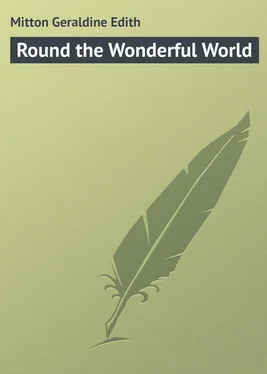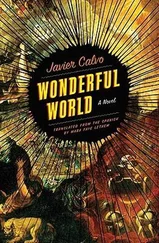Geraldine Mitton - Round the Wonderful World
Здесь есть возможность читать онлайн «Geraldine Mitton - Round the Wonderful World» — ознакомительный отрывок электронной книги совершенно бесплатно, а после прочтения отрывка купить полную версию. В некоторых случаях можно слушать аудио, скачать через торрент в формате fb2 и присутствует краткое содержание. Жанр: Путешествия и география, foreign_prose, foreign_language, на английском языке. Описание произведения, (предисловие) а так же отзывы посетителей доступны на портале библиотеки ЛибКат.
- Название:Round the Wonderful World
- Автор:
- Жанр:
- Год:неизвестен
- ISBN:нет данных
- Рейтинг книги:4 / 5. Голосов: 1
-
Избранное:Добавить в избранное
- Отзывы:
-
Ваша оценка:
- 80
- 1
- 2
- 3
- 4
- 5
Round the Wonderful World: краткое содержание, описание и аннотация
Предлагаем к чтению аннотацию, описание, краткое содержание или предисловие (зависит от того, что написал сам автор книги «Round the Wonderful World»). Если вы не нашли необходимую информацию о книге — напишите в комментариях, мы постараемся отыскать её.
Round the Wonderful World — читать онлайн ознакомительный отрывок
Ниже представлен текст книги, разбитый по страницам. Система сохранения места последней прочитанной страницы, позволяет с удобством читать онлайн бесплатно книгу «Round the Wonderful World», без необходимости каждый раз заново искать на чём Вы остановились. Поставьте закладку, и сможете в любой момент перейти на страницу, на которой закончили чтение.
Интервал:
Закладка:
The ancient Egyptian writing was by signs – a bird meant one thing, a flower another, and a serpent another, and so on, but for a long time the meaning of it had been forgotten, and it was impossible for anyone to read these wonderful signs. But at the very end of the eighteenth century a great stone was found which had upon it an inscription written in Greek and in hieroglyphics, as the sign-writing was called, and also in another writing which used to be employed by the priests, and from this, before many years had passed, clever men were able to understand the language of signs and read the inscriptions on the temples, which told who had built them and much else. This stone was called the Rosetta Stone, after the place where it was found. It is now in the British Museum.
This was long before Luxor was unearthed, and the inscriptions were deciphered as they came to light; by their help it was found that the temple had been built chiefly by two kings, Amenhetep iii. and Rameses ii. who came after him, though not immediately. Rameses added to the existing work and carried it on. So far as we know all this was between three and four thousand years ago. In a village in England people are proud if they can point to any part of their parish church and say, "This is Norman work," and yet the Normans only came over to England less than nine hundred years ago! Go back more than three times that, and try to realise the age of this temple. And even this, as we know, is not old compared with the Pyramids! Doesn't it make us feel that, as a nation, we are rather young after all?
Long before we were a nation these mighty kings flourished in Egypt and lived in pomp and splendour. They each had a different name, of course, and more than one, but yet they were all Pharaohs, just as at one time in the Roman Empire each emperor was a Cæsar.
The Pharaohs had unlimited power in their own dominions, and forced their subjects to work for them as they pleased without giving them any payment. By some means we can't understand these mighty blocks of sandstone composing this temple and many others were brought from a place farther up the river. It is supposed that they were put on great rafts and floated down at flood-time, but the handling of them is still a mystery. The men who dealt with them had no steel tools, no driving force of steam or electricity at their backs, yet they reared buildings which we to-day, with all our appliances, think masterpieces.
Rameses ii. was called the Great; he reigned for over sixty years, and he has a peculiar interest for us because he is believed to have been the Pharaoh who oppressed the Israelites, while his son and successor, Menepthah, was the Pharaoh of the Exodus.
Walk up the great aisle of giant columns into the courtyard at the end, there, between the pillars, stand massive images of granite, most of them headless, but one perfect except for the ends of the fingers and toes.
Sit down on this fallen block and look at that marvellous image; it is the mighty Rameses himself! There is a repressed energy and indomitable purpose about him that tells in every line of a man who never let go and never allowed himself to be thwarted. His almond-shaped eyes and full lips, the proud tilt of his head, are not merely conventional, they are an actual likeness of the man taken from life. He is every inch a king. His successor, who was his thirteenth son, was probably of the same type, and one can well imagine his scornful indignation at being asked to yield up that nation of slaves, the Israelites, whom he treated as we would not treat animals nowadays. The miracle is that Moses was not instantly slain for his boldness in proposing it; he was, of course, screened by his relationship to Pharaoh's daughter, but that would have counted little had he not been protected by a power far above that of the king of Egypt.
Close down under the knee of the standing Rameses is the figure of a plump woman, his favourite wife, Nefertari. The Egyptians had the rather childish idea that size meant importance, and to them now, as well as then, women seemed of much less importance than men, so the wife was represented as being about as high as her husband's knee. In spite of this, however, women of royal blood were treated with great deference, and royal ladies enjoyed a freedom like that of western women to-day. They gave their opinions and transacted business and were seen in public. Many a king only sat securely on his throne because his wife had a better title to it than he had. This did not, however, prevent them from making women very often quite diminutive in size in their statues, though in some cases the king and queen are the same size and are shown seated side by side.
It is very quiet and beautiful here in the temple this Sunday morning; the natives themselves are not allowed to come in, and visitors only on production of a ticket costing twenty-four shillings, which admits to all the temples of Egypt; and, as it happens, there is no one but ourselves. The sparrows twitter overhead in the holes and crannies of the pillars, and the great grey and black crows wheel silently against the blue sky, throwing moving shadows on the honey-coloured columns.
If we walk round the back of these solemn statues we shall see that there is a quantity of deeply cut hieroglyphic writing on a great plaque at the back of each. The name of the king himself is always written enclosed in an oblong space called a cartouche; sometimes this cartouche is supported by two cobras, who are supposed to defend it. The rest of the writing tells of the deeds of the king and all the mighty feats that he performed.
Turning to the walls we find them covered with pictures, not coloured but done in outline by means of deep-cut clean lines. We see the king offering fruit to weird-looking beings with men's bodies and animals' heads – these were the Egyptian gods; there were numbers of them, far too many to remember, but here are a few: Anubis, the jackal-headed; Thoth, the stork-headed; Sekhet, a goddess with a lion's head (some say a cat's). Besides these there were others of great importance: Osiris, the god of the dead, and Isis, his wife – these were the father and mother of Horus, the hawk-headed god. But it was to the glory of Amen-ra, the king or chief of all the gods, who can be recognised in the pictures by two tall feathers like quills standing straight up on his head, that that particular temple was built.
On one of the walls we see a long row of men, all exactly similar, one behind the other – these are some of the numerous sons of Rameses making offerings. You soon notice that in spite of the vigorous and excellent outlines of these pictures there is something funny and stiff about them. That is because the Egyptians had an odd custom of drawing a person sideways, with his two feet in a straight line, one behind the other. No one stands like that in real life, and if you try it you will find how difficult it is not to fall over! Also, though the people they drew were invariably shown from the side, yet the artists used to make them look as if they were squared round in the upper part to show the chest and both shoulders, so that Egyptians in pictures always look oddly wedge-shaped, being very broad at the top and narrow below. The eye was also put into the profile face as if it were seen from the front! Look at any typical Egyptian picture and you will soon pick out these peculiarities. It seems rather a pity they kept so rigidly to these silly notions, as they really drew extremely well; but no artist was original enough to dare to break away from the established custom!
Inside the temple walls all these scenes have something to do with the gods and the offerings made to them by the king, but come outside and on one of the finest bits of wall still standing you will see a most spirited battle-scene. Look at the king in his chariot with the plunging horses! He is drawing his bow and pursuing his enemies, who are dead and dying under his wheels, and fleeing before him. To show how much more important he was than the enemies he had himself made very large and the enemies shown very small. That is not quite our idea of honour and glory nowadays; we should think it more glorious to overcome enemies larger and stronger than ourselves! This afternoon we are going to visit a still larger and more wonderful temple, a mile or two away, called Karnak, and there you will see pictures of the king of that time holding the hair of his enemies' heads in the powerful grasp of his left hand while he prepares to strike off all their heads at one sweep with his sword.
Читать дальшеИнтервал:
Закладка:
Похожие книги на «Round the Wonderful World»
Представляем Вашему вниманию похожие книги на «Round the Wonderful World» списком для выбора. Мы отобрали схожую по названию и смыслу литературу в надежде предоставить читателям больше вариантов отыскать новые, интересные, ещё непрочитанные произведения.
Обсуждение, отзывы о книге «Round the Wonderful World» и просто собственные мнения читателей. Оставьте ваши комментарии, напишите, что Вы думаете о произведении, его смысле или главных героях. Укажите что конкретно понравилось, а что нет, и почему Вы так считаете.












